


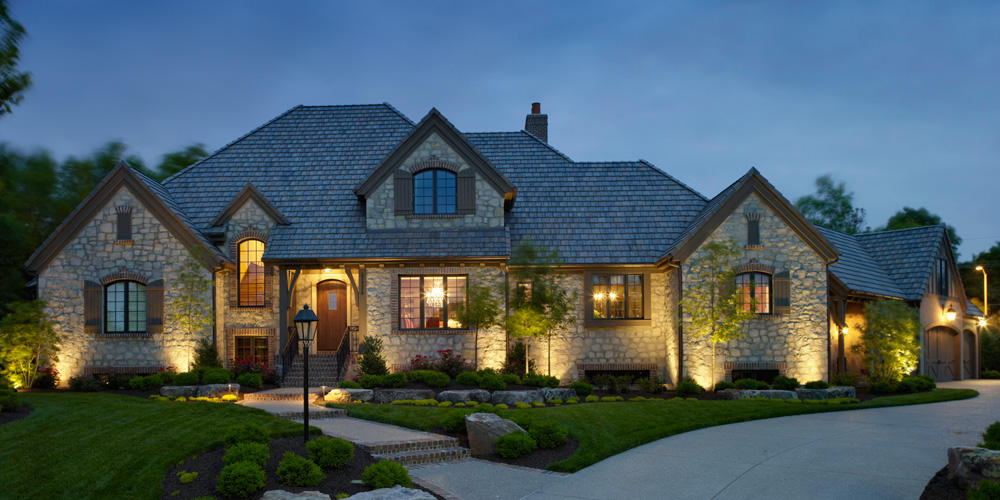
Outdoor lighting refers to fixtures designated to use in outdoor settings. This lighting category includes many sizes, styles, and fixture types. Outdoor lighting systems have diverse applications, from highlighting landscape features to offering additional safety at a door or in dark settings. Outdoor fixtures include solar, hardwire, and plug-in designs. Each outdoor setting calls for a unique system of outdoor lighting, to aptly illuminate the space and ensure a proper level of security.
The principal outdoor fixtures are security/flood lights, wall lights, post lights, ceiling mount lights, and pendants. Common components of outdoor fixtures include:
Finial: a decorative knob or shape appearing at the top or bottom of a fixture
Roof: the cover for the internal housing and bulb of the fixture, often featuring a hinged open for easy changing of the bulb
Cage frame: the main element of the fixture’s design and shape, can include metal framing as well as glass panels
Glass panel: acts as a fixture shade. Protects the bulb and inner housing of the fixture while allowing the bulb to illuminate the surrounding area. Can be crafted from seeded glass, transparent glass, translucent glass, tinted glass, or opaque glass
Glass holder: Binds the panels, frame, and light source
Fitter: also known as a post cap, attaches the fixture to the post (post lights)
Outdoor lighting fixtures are crafted from a variety of metals and marine-grade plastics. Since these fixtures are exposed to the elements continuously, they are commonly treated with a weather-resisting coating or otherwise crafted from naturally durable materials that will withstand wear from wind, rain, and snow. Look for fixtures with a non-corrosive, UV resistant finish for lighting that will perform well in outdoor climates. Many fixtures include grading specifications to designate their ideal usage settings:
UL Damp Location Rating: Best for lights in covered areas
Wet Location Rating: Best for lights directly exposed to the open air
Durable Marine Grade Resin or Solid Aluminum Fixtures: Best for withstanding wear from salty air (locations close to the ocean or beach)
Outdoor lighting fixtures are commonly compatible with one of three types of light bulbs: incandescent, LED, and fluorescent. Fluorescent bulbs are rarely used in outdoor applications. Each of these bulb types carries unique advantages and disadvantages.
Pros: Most popular choice for outdoor fixtures, candle-flame appearance, inexpensive
Cons: Need to be replaced often, use the most energy
Pros: Energy saving, very long lives (up to 20 years)
Cons: Expensive, color varies from traditional incandescent bulbs
Outdoor lighting fixtures can be powered in various ways. Low voltage (12 volts) outdoor lighting systems are the most common. These systems can also be high-voltage or powered by solar energy. Each system has unique benefits and deterrents.
Note: Always consult a professional lighting electrication before purchasing or installing an outdoor lighting system. This guide is not intended to take the place of a professional's best opinion or serve as a technical safety manual.
Low voltage outdoor lighting systems are defined at 10V, 12V or 24V. Low voltage fixtures are a modern option, and were not previously available. Low voltage systems include low voltage fixtures, a transformer or power pack, and a low voltage electrical cable.
Pros: Safer than high voltage systems, more energy efficient, easier to install and adjust
Cons: Requires compatible low voltage equipment (transformer, electrical cable)
High voltage outdoor lighting systems, also known as line voltage, are defined as 120V. Line voltage systems necessitate a conduit to protect wires and an electrical junction box to power the system.
Pros: Same voltage as appliances, lower cost fixtures, bulbs, and installation
Cons: Less energy efficient, difficult to install, high operating costs
Solar powered lighting systems are powered by the natural energy of the sun. These outdoor lighting fixtures commonly include sensors to illuminate only when the light outside passes a set threshold of darkness. Solar powered lights do not require any wiring, and require only minimal installation. These fixtures must receive 6-8 hours of sunlight a day to operate at their full capacity. Solar lights are ideal in settings where power is not available.

Popular features in outdoor lighting systems, motion sensors and timers help to save energy and optimize lighting use. Timers can be programmed to only power outdoor lighting systems at certain hours or for a certain amount of time. Motion sensors only illuminate when they sense movement. This feature can help to deter intruders and ensure a consistently safe and illuminated walkway.
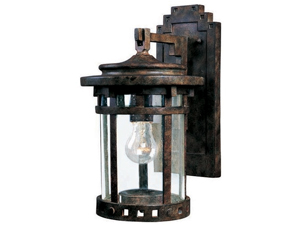
Outdoor wall lighting includes any fixture placed along a vertical surface, such as lanterns and sconces. These fixtures uplight or downlight the surface they are fixed to, and cast a soft, ambient glow over the surrounding landscape. Ideal for use in a variety of outdoor applications, these lights eliminate shadows and illuminate hazards in home and yard design along paths, walkways, stairways or in other dark spaces. Wall lights can be used to highlight doorways or street address numbers on the front of a home. A decorative and functional addition, wall lighting adds instant curb appeal.
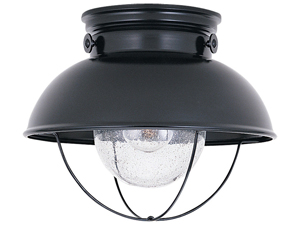
Ceiling lighting offers overhead lighting, to effectively illuminate a fixed radius area below. Popular for installation in porches, entryways, and gazebos, overhead lighting is best suited for areas where a high level of illumination is desired. Two popular ceiling light types are flush mounts and pendant lights. Flush mount lights attach directly to the ceiling, while pendant lights include a rod or chain suspending the fixture housing and bulb at a designated distance from the ceiling. Flush mounts are ideal in spaces with low ceiling heights, or to achieve a more casual aesthetic. Pendants offer a dramatic look, suited to tall or arched entryways. Ceiling lighting is generally installed in high traffic zones.
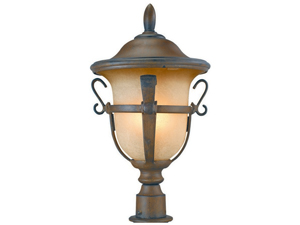
Post lights include fixtures mounted on posts, railings, or fences. These lights are used around pools, along garden paths, along driveways, and in various other applications. Post lights measure low to the ground, highlighting tripping hazards and landscape features, and offering added visibility. Post lights with taller posts will cast a wider light, whereas designs with shorter posts will only illuminate a small area. Many post lights are solar powered, for versatility of styling.
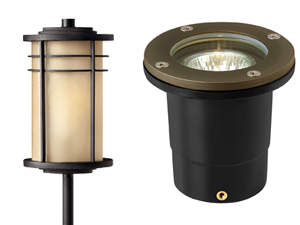
Through uplighting, downlighting, spotlighting, and well lighting, landscape lighting showcases trees, fountains, shrubs, and flowers at night. Landscape lighting can also accent architectural and other landscape features. The category includes path lights, post lights, well lights, and spotlights. Landscape lighting brings an ambient glow and decorative illumination, while also highlighting tripping hazards and other outdoor obstructions. Decks, gardens, and walkways are popular choices for installation of landscape lighting.
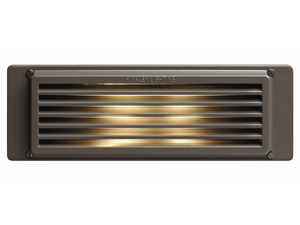
Deck lights or step lights help to illuminate stairs or steps in outdoor settings. Step lights can also be used near pools, driveways, or any setting with an edge or tripping hazard present. Often installed flush with a deck surface or on stair risers, step lights bring security and safety to uneven surfaces.
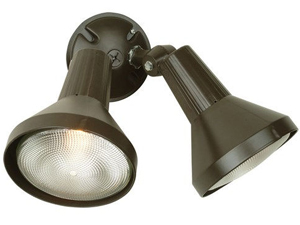
Flood lights are highly illuminating and wide-beamed. These lights “flood” sizable spaces with ample light coverage to deter intruders and increase security around a home. Flood or security lights may feature a motion sensor that causes the light to turn on only when movement is detected. Motion sensors bring an added level of security to flood lights, alerting homeowners to potential criminal activity. Flood lights can also be used to illuminate a sizable area of yard space for late-night games or activities.
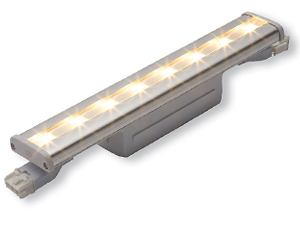
Cove lighting is used to illuminate swimming pools, fountains, signs, paths or other similar spaces. Cove lights are comprised of hidden strips of LED bulbs, for an unobtrusive, long-lasting option with versatile applications.
Energy Star-Rated Lighting reduces energy use and operational costs, while still delivering high-quality features. Both bulbs and fixtures can have an Energy Star certification, granted by the U.S. government.
Dark Sky Approved fixtures help to reduce light pollution. Approved lights minimize glare and protect the nighttime environment, providing ample light without bleeding over into neighbors’ properties or compromising light levels in the nighttime sky. The International Dark Sky Association determines which fixtures are environmentally responsible and will receive a Fixture Seal of Approval.
Contemporary fixtures feature sleek lines and straight-forward styling. Geometric shapes, clean finishes, and modern glass are trademark indicators of the contemporary look.
Transitional lights bridge the gap between traditional and contemporary styles, lifting elements from both new and timeless design for a unique aesthetic. These fixtures may include sleek lines with some decorative ornamentation, elegant curved frames, and light detailing.
Traditional fixtures draw upon time-honored motifs for their design. Traditional lights are highly ornamental, and may recall a vintage European aesthetic. Popular features in traditional design include frosted glass, curved frames, and antiqued bronze finishes.
Popular in country or quaint home design, rustic lighting integrates organic shapes, textures, and weathering for a warm, relaxed look with regained modern appeal.
Craftsman lighting design mimic craftsman home design. Straight, simple lines, sharp angles, and contemporary materials are indicators of the craftsman style. Craftsman lights incorporate artistic hand-made style elements, such as painted finishings and seeded glass.
Contemporary industrial style mimics turn-of-the-century factory design, for a gritty, urban look. These lights use patinaed metals, vintage bulbs, and reclaimed motifs to achieve their signature aesthetic.
Install floodlights at least 9 ft. above ground level. This ensures the fixture cannot be reached or tampered with, and helps to cast a wider radius of light
Wall lanterns flanking the sides of a door or garage should measure ¼ the height of the door or garage
A single pendant or ceiling light above a door or garage should measure 1/3 the height of the door or garage
Outdoor wall lights should measure close to eye level, with 8’-10’ between light sources
5’6” - 6’ above the ground
Path lighting fixtures should be placed evenly, with 2’ - 4’ between light sources
Outdoor lights will appear 50% smaller from 50 feet away; opting for larger outdoor fixtures is always preferable
Balance ambiance with illumination by choosing lower wattage light bulbs when lighting a space with multiple fixtures
Select fixtures crafted from weather resistant materials or shielded by a durable powder coating. Consider moisture, UV exposure, and climate when choosing fixtures, to ensure your lights will stand up to the outdoor elements where they are installed.
If you're ready to shop, browse LuxeDecor's selection of outdoor lighting here.



